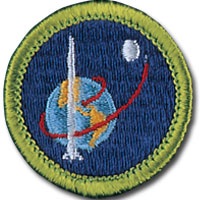SpaceX






Space Exploration Merit Badge Supplementals
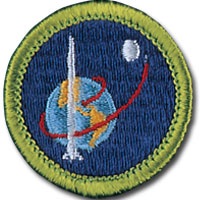
(created Wed. July 15, 2015 - the day after New Horizons visited Pluto)
(updated Tue. June 6,, 2017)
This is an extension of
the Space Exploration Merit Badge page.
The purpose of this page is to provide more information about SpaceX.
The information on this page is NOT required for the Space Exploration Merit Badge.
The information on this page is shared to provide additional insights into the space exploration and to encourage enthusiasm about all that is exciting about the exploring the universe beyond our planet, in person and through unmanned spacecraft.
What are some of the current companies working to launch space missions?
Helpful resources to determine the answer include:
https://en.wikipedia.org/wiki/List_of_private_spaceflight_companies

Because SpaceX now has some major accomplishments in recent months, their mission profiles are shared here.
-
1.Dec. 21, 2015 (Orbcomm-2 LEO / Low Earth Orbit)
-
2.Apr. 8, 2016 (CRS-8 Dragon Mission, to the ISS / International Space Station, in LEO / Low Earth Orbit)
-
3.May 5, 2016 (JCSAT-14 - GTO / Geostationary Transfer Orbit)
-
4.May 27, 2016 (THAICOM 8 - GTO / Geostationary Transfer Orbit)
-
5.March 30, 2017 (SES-10 - GTO / Geostationary Transfer Orbit) - re-launch and re-land the same first stage orbital booster from the Apr. 8, 2016 CRS-8 mission
-
1.Dec. 21, 2015 (Orbcomm-2 LOE / Low Earth Orbit)
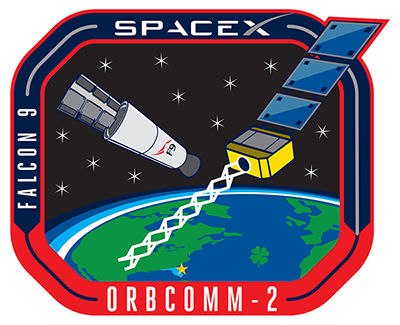
What was special about the Dec. 21, 2015 SpaceX launch of the 11 Orbcomm-2 LOE / low earth orbit satellites?
-
-SpaceX has made several firsts in spaceflight, many in the reuse of the vehicles. SpaceX first announced their privately funded reusable launch system technology development program in 2011.
SpaceX made two attempts to land their first stage rockets earlier in 2015, and in both cases, they landed too hard and crashed.
Then, on December 21, 2015, SpaceX launched eleven Orbcomm satellites into low earth orbit.
Just before those deployed, SpaceX was successful in making the first-ever upright landing of a rocket used to deploy satellites to space.
Note: Blue Origin, landed its New Shepard booster successfully a month earlier, but that occurred during a suborbital test.
SpaceX’s first stage from the Orbcomm-11 mission landed back at Landing Zone One, at Cape Canaveral, on land.
Source: Space dot com article Wow! SpaceX Lands Orbital Rocket Successfully in Historic First, dated December 21, 2015.
Reference video:
ORBCOMM-2 Full Launch Webcast
(45 minute version)
-
-This is the first Falcon 9 (http://www.spacex.com/falcon9) launch since the June, 2015 “anomaly”
-
-The “anomaly”prompted a review of how to prevent the anomaly in future launches; as good engineers, SpaceX reviewed many things about the Falcon 9 (yes, it is named for the Millenium Falcon!), and re-designed and rebuilt them, too. Learn more from “the guy in the purple shirt”, ~ 5:45 - 7:15 minute, in the video.
-
-How to describe the physical changes in the rocket, and its propellant? Hear “Kate” and the interviewer ~ 12:30 minute mark. See, also, the link to “NASA’s fuel of choice” / “fuel of choice,” (Ctl-F to speed to that section, further below), and maybe then re-listen to “Kate” and the interviewer; if you were on the SpaceX team, what variables might you have considered in deciding whether to change propellant types?
-
-Did SpaceX achieve the goal of launching the Orbcomm-2 satellites, completing their “constellation?” See the video’s bottom timeline and jump to ~ 38:30 minute mark, onward.
-
-Did SpaceX achieve the “secondary test objective” of landing the first stage?
The answer can be found ~ 31:00 minute mark.
Here’s a hint:
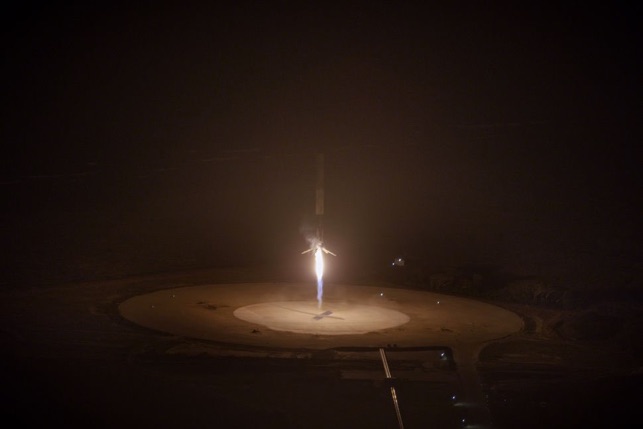
source: http://www.spacex.com/media-gallery/detail/134241/5906
See also: http://www.spacex.com/gallery/orbcomm-2-mission-december-2015
ORBCOMM-2 Full Launch Webcast
(45 minute version)
Falcon 9 First Stage Landing | From Helicopter
“The Falcon has landed” | Recap of Falcon 9 launch and landing
(3 minute version)
https://www.youtube.com/watch?v=ANv5UfZsvZQ
You may also want to read more, about gravity, reusability progress, and more, in this article:
“Background on Tonight’s Launch | December 21, 2015”
http://www.spacex.com/news/2015/12/21/background-tonights-launch
-
2.Apr. 8, 2016 (CRS-8 Dragon Mission)
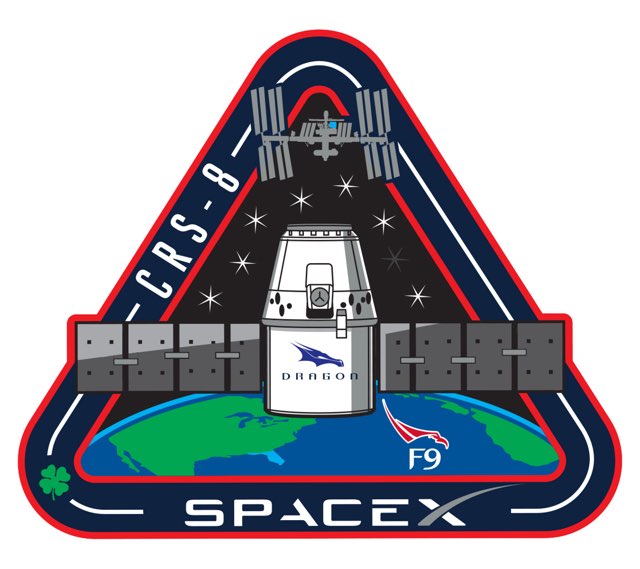
What was special about the Apr. 8, 2016 SpaceX launch of the Dragon module, which resupplied the ISS / International Space Station?
- First landing on the drone ship “Of Course I Still Love You.”
Reference video:
CRS-8 | First Stage Landing on Droneship
(39 second version)
https://www.youtube.com/watch?v=sYmQQn_ZSys
-
-“Mission Update
Early Sunday morning (EST), Dragon was attached to the International Space Station and will remain there for about a month before returning to Earth with critical science and research payloads for NASA. To follow the Dragon mission, visit www.nasa.gov/spacex. Early this morning, the Falcon 9 first stage that landed on our droneship returned to Port Canaveral. Click here for a pic: https://www.instagram.com/p/BEFyQh0F8eB/?taken-by=spacex. To rewatch the CRS-8 launch webcast, see below. For 4K quality video of landing, see here: https://www.youtube.com/watch?v=sYmQQn_ZSys. Launch and landing photos are available at www.flickr.com/spacex.”
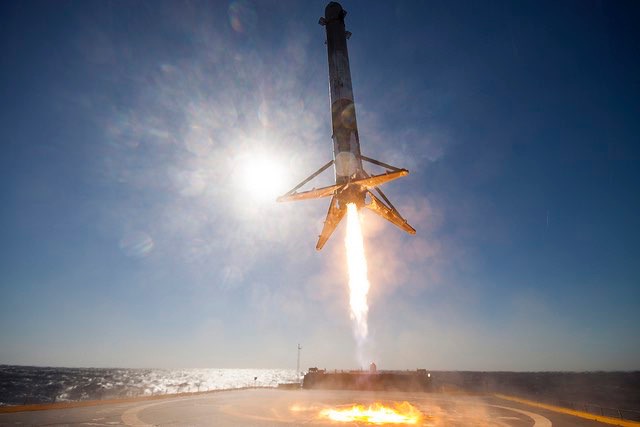
source: https://flic.kr/p/FhNjoh
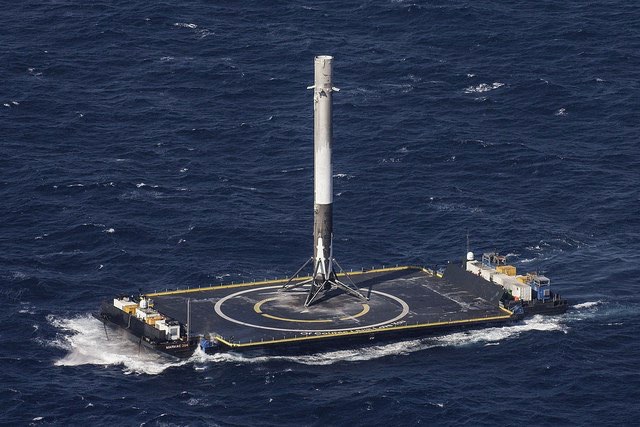
source: https://flic.kr/p/FYDQw9
-
3.May 5, 2016 (JCSAT-14 Geosynchronous orbit)
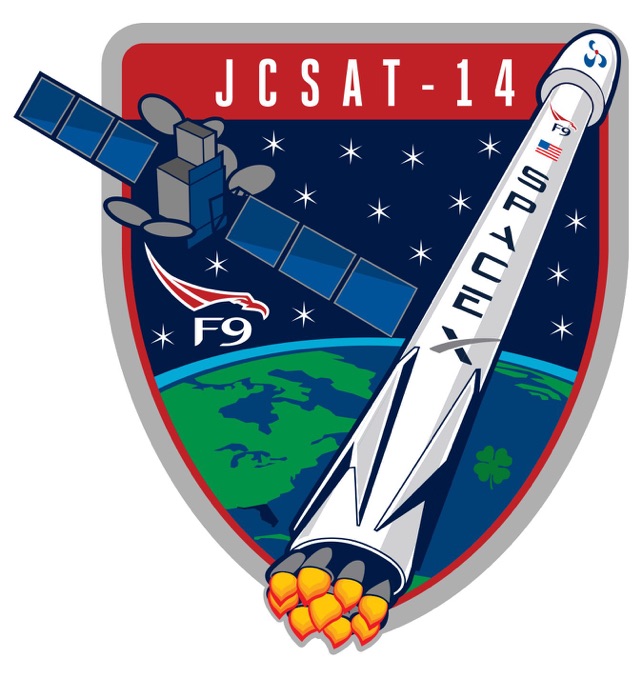
JCSAT-14 Full Launch Webcast
(54 minute version)
“Three Camera Angles | Falcon 9 First Stage Landing on Droneship”
(89 second version)
https://www.youtube.com/watch?v=LHqLz9ni0Bo&feature=em-subs_digest
What was special about the May 5, 2016 SpaceX launch of the JCSAT-14 geosynchronous transfer orbit satellite?
Several sections of the JCSAT-14 Mission video are very informative:
-
-4-5 and 28:06-29:25 minute mark about launch forces
-
-7-8:45 minute mark about the satellite itself
-
-10-10:50 and 14:50-16:50 minute marks for GTO definition
-
-10:50 - 12:55 min mark about the thrusters and how they work
-
-29:25-32 for the first stage landing on “Of Course I Still Love You”
-
-49:30 min mark - animation of the launch and satellite orbit
-
-52 min mark - why the second stage engine bell is different than those on the first stage
-
-53 min mark - JCSAT-14 satellite deployment (over central Africa)
-
4.May 27, 2016 (THAICOM 8 - GTO / Geostationary Transfer Orbit)
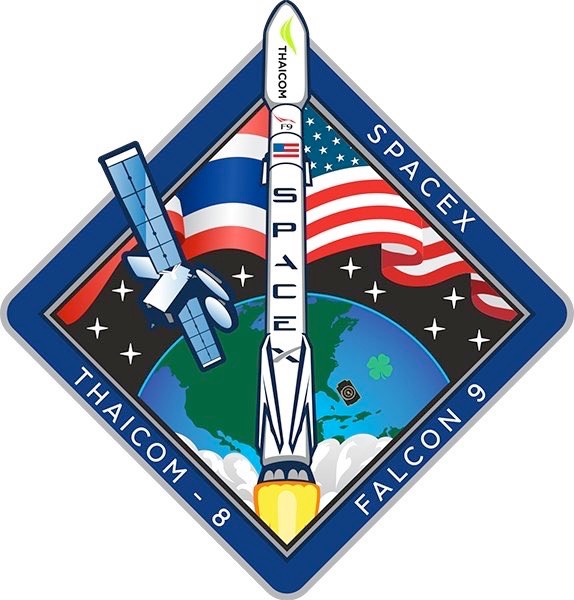
THAICOM 8 Launch Webcast
(54 minute version)
“First-stage landing | onboard camera”
(30 second version)
https://www.youtube.com/watch?v=4jEz03Z8azc
What was special about the May 27, 2016 SpaceX launch of the THAICOM 8 geosynchronous transfer orbit satellite?
-
-Third landing, and one which showed the re-entry of the first stage, all the way to landing... live!
Primarily:
-
-27 min mark - Seeing some of the first stage’ re-entry burns
(which are showed in full in the 30-second video) -
-2 min mark - Why SpaceX launches at Cape Canaveral
-
-3 min mark - Use of Oxygen and Kerosene for fuel
-
-8 min mark - a bit about the satellite and THAICOM
-
-8:30 min mark - differences between GTO & GSO orbits
-
-15:45 min mark - plan to reuse the rocket from the third landing
-
-21 min mark - countdown to launch
-
-29:30 min mark - landing on “Of Course I Still Love You”
-
-48 min mark - second stage burn
-
-52 min mark - animation of the launch and satellite orbit
-
-53 min mark - THAICOM 8 satellite deployment
-
5.March 30, 2017 (SES-10 - GTO / Geostationary Transfer Orbit)
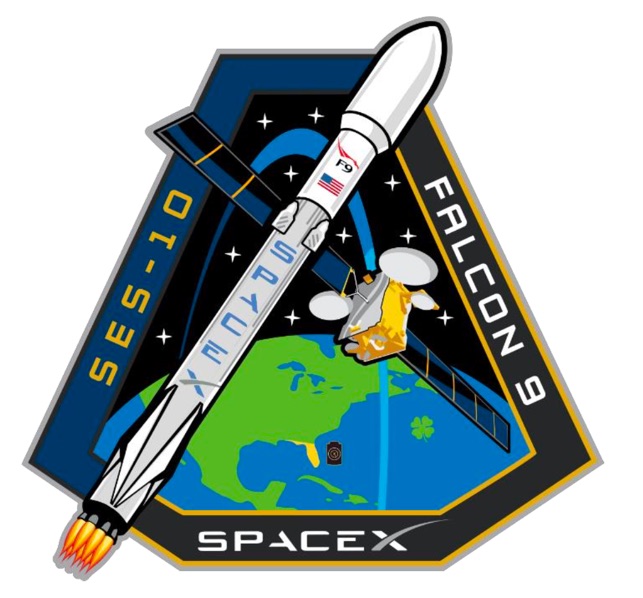
SES-10 Hosted Webcast
(53 minute version)
What was special about the March 30, 2017 SpaceX launch of the SES-10 geosynchronous transfer orbit satellite?
Re-launch and re-landing of the first stage orbital booster that launched and landed on the Apr. 8, 2016 CRS-8 mission. This is an historical first - this is the first time an orbital booster was re-launched... and re-landed!
-
-SpaceX was the first company to reuse an orbital booster. That accomplishment is the culmination of steps from two missions.
First, in April, 2016, SpaceX launched CRS-8, which stands for Commercial Resupply Services mission eight, sending supples on its Dragon capsule to the ISS, the International Space Station. On that mission, SpaceX landed the first stage on its ocean drone-ship landing platform named ‘Of Course I Still Love You.‘
On March 30, 2017, SpaceX successfully relaunched the April, 2016 first stage from CRS-8 and landed it back on ‘Of Course I Still Love You,’ the first successful re-launch and re-land of the first stage of an orbital rocket
-
-Re-launch and re-land the same first stage orbital booster from the Apr. 8, 2016 CRS-8 mission
-
-19:00 min mark - Launch / Re-Launch
-
-21:00 min mark - first stage separation
-
-26:45 min mark - Landing on Of Course I Still Love You
-
-50:00 min mark - SES-10 satellite deployment
The ascent
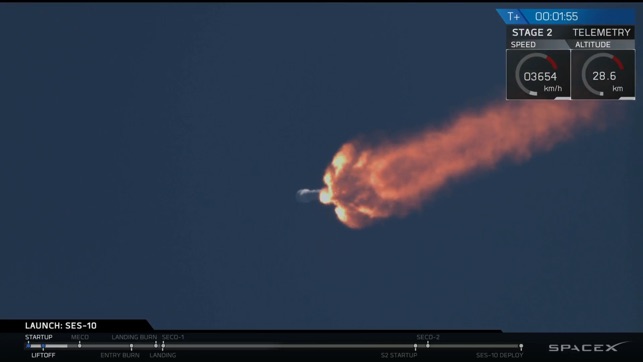
The first stage separation

Landed on Of Course I Still Love You
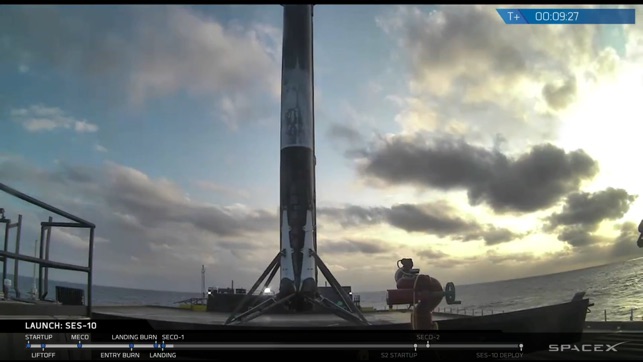
In November, 2015, we visited family in Yucaipa, CA, for Thanksgiving. Since (1) the best-priced flights were into LAX (Los Angeles International) and out from ONT (Ontario, CA), and (2) since LAX is not too far from Hawthorn, CA, and (3) since you can see the SpaceX building from I-105, we visited SpaceX.
At least then, in the busy days re-designing and re-building the Falcon 9, still before the Orbcomm-2 launch, SpaceX did not offer public tours, so we just drove around the outside of the buildings, which are part of a properly large complex - they do build actual rockets in there, after all!
We did also see the properly secured entry gates, where they drive the Tesla cars in for that company’s promotional videos (like the Sept. 29, 2015 launch of the Model X - https://www.teslamotors.com/modelx). You can see more inside the building in the “Full Launch Webcast” video. For now, we share these two photos:
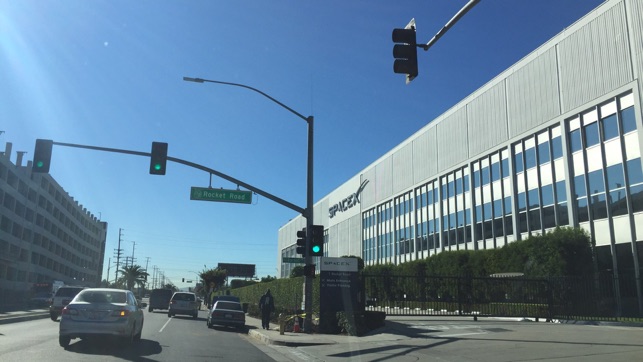
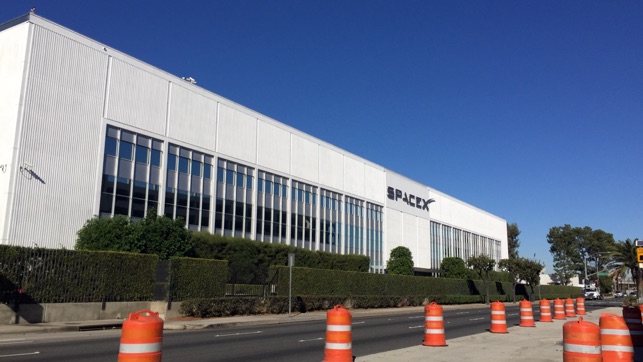
What makes SpaceX more innovative than other companies?
-
-“SpaceX designs, manufactures and launches advanced rockets and spacecraft. The company was founded in 2002 to revolutionize space technology, with the ultimate goal of enabling people to live on other planets.”
-
-source: http://www.spacex.com/about
-
-“The world’s first reusable rockets.”
-
-source: http://www.spacex.com
-
-“SpaceX was founded in June 2002 by Elon Musk; his vision was to build a simple and relatively inexpensive reusable rocket that would go into space multiple times, similar to the turn around time capabilities that commercial airliners currently exhibit.“
-
-“Musk has stated that one of his goals is to improve the cost and reliability of access to space, ultimately by a factor of ten.”
-
-“He stated in a 2011 interview that he hopes to send humans to Mars’ surface within 10-20 years.”
-
-source: https://en.wikipedia.org/wiki/SpaceX
What are some of the innovations that private firm SpaceX has brought to space exploration?
-
-September, 2008
“The first privately funded, liquid-fueled rocket (Falcon 1) to reach orbit (28 September 2008).” -
-July,2009:
“Falcon 1, Flight 5 makes history, becoming the first privately developed liquid fuel rocket to deliver a commercial satellite to Earth orbit.” -
-December, 2010:
“On December 8, 2010, Dragon became the first privately developed spacecraft in history to re-enter from low-Earth orbit.” -
-May, 2012:
“Dragon becomes the first private spacecraft in history to visit the space station.” -
-December, 2013:
“Falcon 9 reaches Geosynchronous Transfer Orbit.”
-
-April, 2014:
“Falcon 9 first stage successfully lands in Atlantic Ocean.” -
-WOW: NOT easy, by WAY awesome! CRS-6 First Stage Landing
-
-February, 2015:
“the launch of the Deep Space Climate Observatory (DSCOVR) on 11 February 2015 was the company’s first delivery beyond Earth orbit.”
Source: http://www.spacex.com/about & https://en.wikipedia.org/wiki/SpaceX



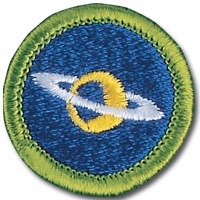
These are all of the links to the Astronomy Merit Badge pages:
Astronomy Merit Badge - Extra “Fun Facts”
Astronomy - Great American Eclipse
Astronomy - Great American Eclipse 2017

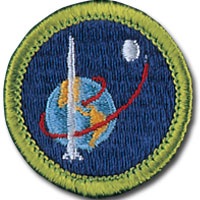
These are all of the links to the Space Exploration Merit Badge pages:
New Horizons - Mission Overview
New Horizons - Pluto Resources


All images were scanned directly from the magazine using the Halo Scanner Mouse - http://shop.halo2cloud.com/collections/computer-and-backup/products/scanner-mouse, which I received as a Christmas present from my mother in 2013.



Regardless your desire to pursue a career in space exploration, it is hoped that you learned enough about exploring space through this merit badge to at least be interested to continuously look up at the sky in awe and wonder, and think about what you may want to explore if you were to go “out there” or were to send a probe “out there.”
If you pursue with enthusiastic interest, that’s great. If you do make a career in the field, GREAT.
May all be better off having completed your Space Exploration Merit Badge than you were before you started.
